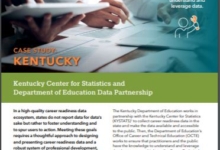Connecting data systems is a critical strategy to help policymakers measure learner outcomes and make informed decisions that better prepare learners for success in the workforce. While state agencies, spurred by technological advancements and federal funding, are making significant progress to connect postsecondary, employment and social service data systems, integrating information effectively poses challenges.
This case study from the Workforce Data Quality Campaign (WDQC) profiles several data systems in Illinois to demonstrate how organizations have collaborated to connect data in a way that empowers policymakers to make informed decisions. The systems profiled in the case study are the Chapin Hill Integrated Database at the University of Chicago, the Chicago Area Workforce Information Systems and the Illinois Longitudinal Data Systems.
Drawing on findings from the case study, WDQC makes the following recommendations:
- Identify data needs and determine gaps
- Develop longitudinal integrated data systems
- Turn to end-user advice
- Reach out to research institutions
- Make privacy and security manageable priorities







